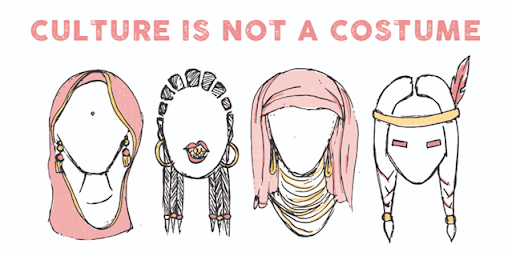Culture is not a costume

PHOTO COURTESY OF STOUTONIA.COM
November 5, 2021
You’ve likely seen it before. During your annual Spirit Halloween trip, you’ve stumbled upon certain unfavorable costumes: the “Noble Savage” the “Graceful Gyspy” or even the “Macho Man.” All these getups have one thing in common: they perpetuate harmful stereotypes.
America has long struggled with cultural appropriation. This term is defined as the “inappropriate adoption of an element of culture.” It’s everywhere: our movies, fashion, and even our Halloween attire. It’s surprising to think such a fun holiday could also be a main site of such negativity.
It’s true that we as a country have gotten better. We now understand the degrading history behind blackface, and yet, every year you can still see offensive costumes characterizing other minorities, often Native Americans.
The problem with these costumes is that it dehumanizes the cultures they depict. Take for example, the always-popular “Native American” costume. Just slip on some suede boots, fringe and a beaded headband and you’ve now represented an entire culture. However, this portrayal is one frozen in time. Most “Native American” costumes are modeled around the traditional “Ghost Dance” shirt. This garment was worn to protect its wearer from violence. The reason it was so popular at the time results from colonists forcing Native Americans from their lands, and down the Trail of Tears. The shirt was also worn by many during the Indian American Wars, which killed over 74,000 Native Americans. This is how America continues to remember their culture, as “Noble Savages.” No respect is given to the Native people when these costumes portray them at one of their darkest times in history.
But Native Americans are not the only victims of cultural appropriation. The term “gyspy” has been around since the 1600s and has now recognized as a derogatory term towards Romani women. However, the term still pops up on costumes everywhere. The entire Romani culture is summarized as a scandalous outfit, with flowing scarves and jingling bells. These “Gypsy Fortune Teller” outfits promote a serious stereotype: one that has led to centuries of the displacement and persecution of the Romani people. Still today, although their culture is secretive and held close to heart, corporate Halloween has found a way to monopolize off of it. As a result, the Romani culture is catered to the masses as a “sexy fortune-teller” that is sure to make heads turn. But maybe not in the best way.
Another popular “costume” genre is one that’s been aided by the film industry for decades: those displaying Mexican stereotypes. For years, Hollywood films have included one dimensional characters like the “Latina Lover” or the “Bandito.” You can see these characters in every Halloween store. A whole culture, stuffed in a vacuum-sealed plastic bag. It may seem like a humorous caricature to some, but for those that personally identify with the Mexican heritage, it can be embarrassing and degrading. Latina women are sexualized, with costumes consisting of high cut dresses and pointy stilettos. It’s not fair that a movie trope has to define an entire population.
A culture cannot simply be taken on or off. It is not a costume. Cultural appropriation is something this holiday can do well without. Still interested in adopting a new identity? Consider an intergalactic alien or a mystical mermaid. The popularity of culturally appropriative costumes has to be curbed, for the sake of every culture they crudely portray.


